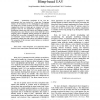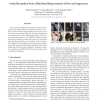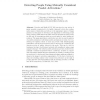327 search results - page 49 / 66 » Disambiguating the recognition of 3D objects |
CVPR
1997
IEEE
14 years 11 months ago
1997
IEEE
This paper describes an efficient approach to pose invariant object recognition employing pictorial recognition of image patches. A complete affine invariance is achieved by a rep...
ICRA
2005
IEEE
14 years 3 months ago
2005
IEEE
- Autonomous navigation in 2D and 3D environments has been studied for a long time. Navigating within a 3D environment is very challenging for both animals and robots and a variety...
CVPR
2011
IEEE
13 years 6 months ago
2011
IEEE
We present a distributed representation of pose and appearance of people called the “poselet activation vector”. First we show that this representation can be used to estimate...
CAIP
2009
Springer
14 years 4 months ago
2009
Springer
Most object detection techniques discussed in the literature are based solely on texture-based features that capture the global or local appearance of an object. While results indi...
ECCV
2010
Springer
14 years 2 months ago
2010
Springer
Bourdev and Malik (ICCV 09) introduced a new notion of parts, poselets, constructed to be tightly clustered both in the configuration space of keypoints, as well as in the appeara...



